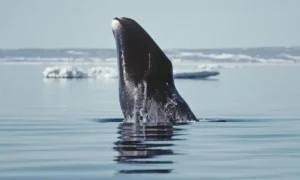BOWHEAD WHALE
Balaena mysticetus
Linnaeus, 1758

Photo: Alamy
DERIVATION: from the Latin balaena for whale.
In its Arctic home, the bowhead whale holds its huge mouth open as it slowly swims through food-rich waters, letting the water flow through its baleen. When the whale has captured a large number of invertebrates, it closes its mouth and swallows the meal. The enormous head of a bowhead occupies nearly one-third of an adult’s body size. The top of the huge head is curved and narrow (like a bow). Its tongue may weigh a ton. A 19th century whaling captain, Scoresby, wrote “...when the mouth is open it presents a cavity as large as a room.” From the upper jaw of the massive curved mouth, as many as 300 triangles of narrow baleen may hang. The bowhead’s baleen is by far the longest of any whale, reaching a recorded length of 15 feet, but averaging 10-11 feet.
Over 100 years ago, baleen was used for many items which made it very valuable to whalers. “Whalebone,” as it was called, was used for umbrellas, corsets, springs for horse-drawn carriages or anything that needed a tough, springy material. Baleen is not bone at all, but a keratinous substance similar to the nails and hair of humans.
Bowhead migration patterns seem to depend on ice formation and movement. In fall, they abandon their high altitude feeding grounds just before ice forms. If they leave too late, they run the risk of becoming icebound. Death could result from suffocation if a bowhead is trapped under ice. A bowhead’s large head is capable of breaking through three inches of ice.
Bowhead whales use underwater sounds - described as low moans - to communicate while they are socializing, traveling and feeding. Long repetitive songs are displayed by some whales that may be related to mating. Sexual activity has been observed between pairs, as well as groups of several males and one or two females. Bowheads commonly travel alone or in small groups of up to six animals. Larger congregations of bowheads are found at feeding grounds. Bowhead whales feed on planktonic organisms including copepods, amphipods, euphausiids, and various other crustaceans. They consume about two tons of food a day. It is estimated that calves are probably born every three or four years after a gestation period of 13-14 months. Sexual maturity is reached at 38 feet. Births apparently occur in spring/early summer and calves are weaned 9-15 months after birth. A newborn is about 17 feet long and weighs about 5-6 tons. The calf is born tail first, which is common for cetaceans, and it instinctively swims to the surface to breath. It may be helped by its mother using her flippers.
Like its close relative, the right whale, the bowhead lacks a dorsal fin. The bowhead has two blowholes and therefore spouts two jets of breath which form a V. Its deeply notched flukes (tail) when mature can measure 25 feet from tip to tip. Its flippers (pectoral fins) are broad and paddle-shaped and about six feet in length. Its maximum length is 60-65 feet and its weight is about a ton per foot; females are larger than males. Adult males reach physical maturity at 50 feet and may weigh in excess of 60 tons. Bowhead color is blue-black except for a splotch of white on their chin called a vest. They have a few stiff hairs at the front of both the upper and lower jaws. There may be white markings on their stomach and a gray-white band just in front of their fluke. The patch near the tail turns whiter and larger with age, and very old bowheads may have all-white tails. There is increasing speculation that a bowhead’s life expectancy may be over 100 years.
Four or five separate stocks of bowheads inhabit Arctic waters. Off of Alaska, the bowheads spend the winter months in the southwestern Bering Sea and migrate northward in the spring. They follow openings in the pack ice into the Chuckchi and Beaufort seas. The killer whale or orca is their only natural enemy. Man has nearly wiped out the bowhead due to excessive hunting for baleen and oil. For an animal of such a large size that was hunted for three centuries, very little is known of its life history. Due to overhunting, its numbers are dangerously low. The bowhead is an endangered species and has been protected since 1935. Commercial whaling of bowhead populations began in the 1600s near Greenland. Whalers would wipe out entire herds of whales in one area and move on to other bowhead stocks. In the North Pacific, commercial whaling began in the mid-1800s. Within two decades, over 60 percent of the bowhead population had been wiped out. Population of bowheads has increased off Alaska since commercial whaling ceased. In 1990, it was estimated at about 7,800 animals. Native populations are allowed to take small numbers each year, and those numbers are set by the International Whaling Commission.
Because of its precariously low numbers, the bowhead would be particularly vulnerable to habitat degradation.
